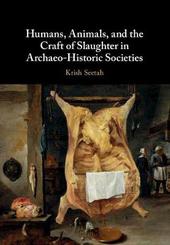
|
Humans, Animals, and the Craft of Slaughter in Archaeo-Historic Societies
Hardback
Main Details
| Title |
Humans, Animals, and the Craft of Slaughter in Archaeo-Historic Societies
|
| Authors and Contributors |
By (author) Krish Seetah
|
| Physical Properties |
| Format:Hardback | | Pages:276 | | Dimensions(mm): Height 261,Width 184 |
|
| Category/Genre | Archaeology
Archaeology by period and region
Prehistoric archaeology
Zoology and animal sciences |
|---|
| ISBN/Barcode |
9781108428804
|
| Classifications | Dewey:930.1 |
|---|
| Audience | | Professional & Vocational | |
|---|
| Illustrations |
Worked examples or Exercises
|
|
Publishing Details |
| Publisher |
Cambridge University Press
|
| Imprint |
Cambridge University Press
|
| Publication Date |
25 October 2018 |
| Publication Country |
United Kingdom
|
Description
In this book, Krish Seetah uses butchery as a point of departure for exploring the changing historical relationships between animal utility, symbolism, and meat consumption. Seetah brings together several bodies of literature - on meat, cut marks, craftspeople, and the role of craft in production - that have heretofore been considered in isolation from one another. Focusing on the activity inherent in butcher, he describes the history of knowledge that typifies the craft. He also provides anthropological and archaeological case studies which showcase examples of butchery practices in varied contexts that are seldom identified with zooarchaeological research. Situating the relationship between practice, practitioner, material and commodity, this imaginative study offers new insights into food production, consumption, and the craft of cuisine.
Author Biography
Krish Seetah is Assistant Professor of Anthropology at Stanford University. He brings vocational experience as a professional butcher to his research on environmental archaeology, especially human-animal interactions, and the ecological consequences of colonialism. He is the author of Bones for Tools - Tools for Bones: The Interplay Between Objects and Objectives (2012) and Connecting Continents: Archaeology and History in the Indian Ocean (forthcoming).
|